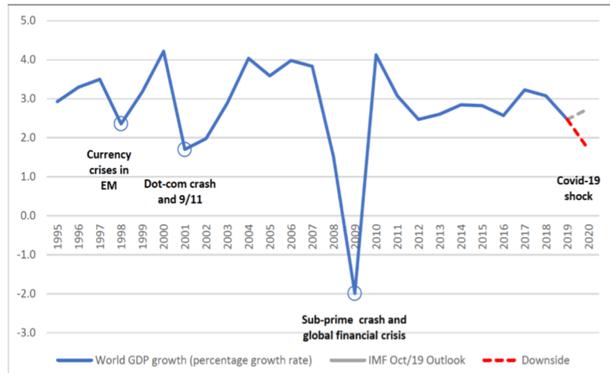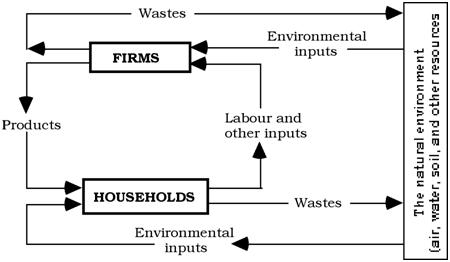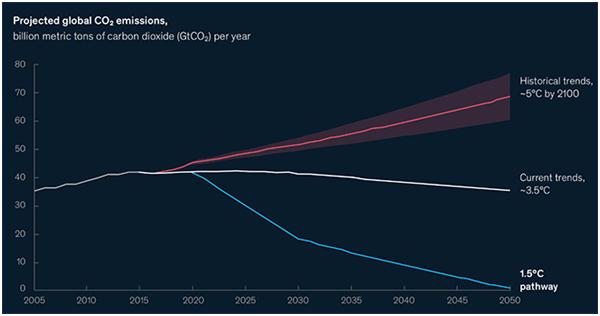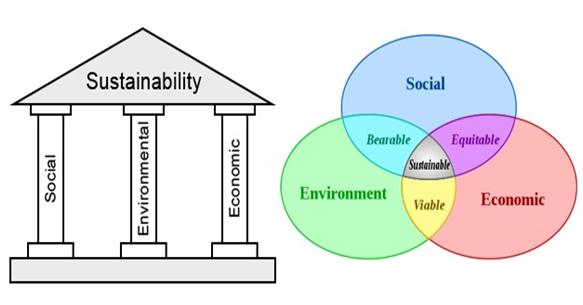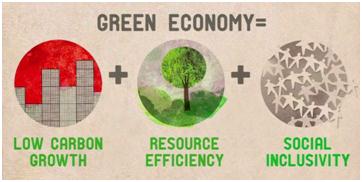Climate policy in 2021 - Balancing domestic ambitions and global cooperation
The landmark Paris Agreement, a commitment to limit the global temperature increase to below 2 degrees centigrade above pre-industrial levels was signed by 195 countries and came into effect in 2020. The actions taken by the global community in this decade would determine the success of the agreement and would be the ‘sole’ deciding factor for the survivability of our planet.
The landmark Paris Agreement, a commitment to limit the global temperature increase to below 2 degrees centigrade above pre-industrial levels was signed by 195 countries and came into effect in 2020. The actions taken by the global community in this decade would determine the success of the agreement and would be the ‘sole’ deciding factor for the survivability of our planet.
The current state of discussions is suggestive of three broad trends that would evolve over the next few years. Policymakers in some countries have recognised that environmental policy could support economic growth and development. In general, these countriespossess the financial resources for investing inclimate action. It gives a reason for hope. On the contrary, the risk of unequal economic prosperity in some countries forces them to make in effective efforts to combat climate change. Lastly and sadly, some of the wealthier countries have shifted focus to their domestic concerns and seem increasingly reluctant to support low-income nations that face financial and technological constraints to climate action.
The Paris Agreement
The Paris Agreement is a multilateral agreement within the UNFCCC signed to reduce and mitigate the greenhouse gas emissions. The goal of the Paris Agreement is to reduce the rise of global temperature below 2degree Celsiusabove pre-industrial levels in this century and make efforts to limit the increase to 1.5 degrees Celsius. Additionally, it reiterates the obligationof developed countries towards developing countries, for providing financial and technological support.The developed countries have committed $ 100 Billion a year of Financial Support. Further, there has been an announcement of $ 3 Billion commitment for Green Climate Fund.The agreement talks about 20/20/20 targets, i.e. Reduce carbon dioxide emissions by 20%, Increase the renewable energy market share by 20%, and Increase the energy efficiency by 20%.
The Paris Agreement 2015 changed the terms of the agreement on climate action fundamentally. All countries have prepared Nationally Determined Contributions (NDCs) that refers to the contributions that need to be performed by each country to achieve the overall global goal of limiting the rise of temperature. However, countries like the United States of Americado not want this dealas it puts too much onus on wealthier countries to make reductions. Lately, it has been reported that the sum of all the NDCs would add up to at least 3°C temperature increase by the end of thecentury. However, hopes are high asthe U.S. for once has been roped inand to keep the temperature rise below 1.5°C it is mandatory to amplify the NDCs and the countries should realise the need of taking more drastic actionsto minimise theimpact ofclimate change that could hit them.
The Impact of COVID-19 on the planet
The world has been grappled with COVID-19 since the first half of 2020. Lockdowns had to be imposed across the nationswhichaimed at arresting the spread of the pandemic. It left little choice for policymakers to utilise financial resources for climate action and the available resources had to be diverted for improving the public health and stabilising the economy. Additionally, various early stimulus announcements from the G20 economies were estimated to direct only 0.2 per cent of spending towardsgreen sectors. The COP26 summithad to bepostponed to 2021.
The various developments started to change by the mid-2020, when it became clearer that the pandemic and its impacts would be more severe than the initial anticipations. Surprisingly,this heightened the political support for climate action. Policymakers finally began to understand the massive impacts that such shockscould have on the growth of thenation. Furthermore, the importance of building resilience in the economic machinery was appreciated. Additionally, the United Nations call for “building back better” started to gain traction given the necessity for government investment in restarting the economies throughout the planet.
By the end of July 2020, the European Union had announced the biggest green stimulus in history, allocating around US$600 billion to climate action. Further, it made a pledge to become the first climate-neutral continent by 2050. Over the next few months, China, Japan and South Korea made similar pledges.The number of countries that have committed to carbon neutrality by the middle of the century has risen to 110. This number is set to rise when the Biden-Harris administration takes the helm in the White House. Before 2020 had ended, leaders from 75 countries had come together to present updated commitments at the virtual Climate Ambition Summit which was held to mark the fifth anniversary of the Paris Agreement.
It has become clear that out planet is in crisis and the failure to act is failing humanity. Addressing the current coronavirus pandemic and protecting ourselves against future global threats would require sound management of hazardous waste, global supervision and care of nature and biodiversity, a clear commitment towards “building back better”, creating green jobs and facilitating the transition to carbon neutral economies. It has been realised that humanity would depend on immediate actionsneeded for a resilient and sustainable future.
The Great Economy vs Environment Myth
Environmentalism is unfortunately still thought to be only about protecting trees and saving animals instead of trying to protect the environmental conditions necessary to ensure the health of people all over the world. Many consider environmentalists to be critical and dismissive of any type of resource extraction or energy production and job creation or the impact environmental regulations could have on the profitability of certain industries. Similarly, any action taken to protect the environment is seen as detrimental to the health of the economy. However, this perception is often correct in the short term. Stricter pollution regulations could hurt the profitability of companies and decrease the speed at which they could expand their operations. Further, renewable energy could be more costly to produce at several instances. Thankfully, government support has made it more viable and the support will need to be continued since these are cleaner and greener alternative.
The problem with such a perception is that the economy and environment are not in opposition with one another. One cannot combat poverty, disease, or suffering without a stable climate and a healthy environment and one cannot improve a struggling economy either. A healthy environment is a prerequisite for a healthy economy. The economy relies on the planet’s ability to provide resources and the necessities of life.Pollution and climate change has the potential to trigger the biggest global recession ever.
For example, climate change presents a growing, long-term economic burden for Canada. According tothe report of National Round Table of the Environment and Economy in Canada, climate change could start costing Canada in billions by 2020 and$43 billion a year by 2050. Disruption to Canada’s timber industry(arising from changing environmental conditions), a drain on health care system (from warmer weathers and increased premature deaths), flooding in coastal areas and many other factors could be reason for the economic burden. The report did not incorporate the impacts felt from global factorslike a rise in the cost of food, and an increase in the need for humanitarian funds to help those affected by the drastic increase in extreme weather patterns. Taking that into consideration makes the future look grim for Canada’s economy.
According to reports,climate change is to be blamed for the rise in the cost of food. Food prices, as with energy, have a trickle-down effect on the rest of the economy.When the people have to pay more for food it causes inflation,it means everyone spends less on everything else. The more climate change creates harsher conditions that are detrimental to global food production, the more the global economy would suffer.While it might be possible to put a dollar figure on the costs involved in relocating people, providing humanitarian aid to countries experiencing drought, and the clean-up of areas that have experienced extreme weather or flooding, calculating the cost of human suffering involved in those occurrences and putting a dollar figure on it would be impossible.
The Optimistic Rendezvous: Environmental protection and economic growth are no longer at the opposite poles
The discussions at the Climate Ambition Summitare an indicator of the path that climate action would take. At the Paris Summitin 2015, the narrative was focused upon the trade-offs between environmental sustainability and economic growth. In theClimate Ambition Summitin 2020, the leaders had recognised climate action as an opportunity to generate jobs and growth. It was indeed a huge achievement and a testament to what could be possible when governments, finance and technology enter a virtuous cycle of policy, investment and innovation.
While the current discussions on climate action tend to focus around how far we are from the 2 degree Celsius target, it would be vital to consider how far we have come. The figure given below (Source - McKinsey & Company) shows projected CO2 emissions up to 2050. The policies in place just five years ago would have led to increase in theemissions consistently over the next three decades. However,McKinsey & Companyhave projected a gradual decline till the middle of this century. As the climate targets would increase in ambition, emissions would have plenty of scope to decrease further to the 1.5 degree Celsius goal.
In the coming decades, the shift to a low-emission path appears highly viable. The COVID-19 pandemic had brought travel to a standstill, and various forecasts are suggestive of the fact that the demand for crude oil is unlikely to recover completely in the years ahead. New transport technologies are developing and maturing rapidly. This not only includesthe electric vehicles, but also ships and aircraftpowered by hydrogen. These technologies run onclean sources of energy and would provide green alternatives for long-distance travel and transport. Solar power has now become the cheapest form of electricity in human history, and installation of new solar power plants cost much less than coal,includingdeveloping countriessuch as India. The implications for these countrieswould be huge as they need to build new power capacity to feed the energy demanding citizens. India would need 86 percent less coal up to 2040 than what earlier forecasts had assumed. Investments in coal power are declining rapidly in many of the developing countriesin Asia.
As the new technologies are scaling up, their costs are declining rapidly. We have already seen this trend at play.Goldman Sachshas estimated that the annual costs of accomplishing net-zero emissions by 2050 would cost US$1 trillion less than they had forecasted in 2019. This has mainly been due to the rising demand, and the resulting rise in production of the newer and cleaner technologies. This has supported the creation of a connected ecosystem for decarbonisation. Correspondingly, the fundsthat have been allocated for sustainable investments are increasing rapidly. The fundslinked to Environmental, social and governance sectors had attracted net inflows of US$71.1 billion globally between April and June 2020, which was more than the combined fund flows for the previous five years. The market for green bonds has grown by 300 percent in the previous five years, and could increase further as various countries would issue green sovereign debt to finance the economic recovery after the COVID-19aftermath.
As the investors would allocate funds on the basis of carbon footprint, companies would be forced to take action. Recently, the number of companies with net-zero emissions targets has grown by 300 per cent since 2019. It includes some of the biggest companies around the world such asMicrosoft, Unilever and Amazon. Importantly, some of the companies have gone furtherby setting up funds for climate innovation. Governments have been ramping up investments in clean energy and infrastructure, to ensure that companies with net-zero targets continue to operate in their jurisdictions.Most importantly, from the perspective of the political leaders, ‘green’ economic activity would favour the creation of more and better jobs. It would enable them to makeclimate-friendly policieswhich would be increasingly attractive to voters. Further, even the conservative International Monetary Fundhas encouraged a green investment push in the recent past, despite elevated debt levels. The International Monetary Fund has stated thatthe green investment pushwouldencourage job creation, raise demand, and boost faster recovery.
The Challengeof less inclusive Climate multilateralism
While it has become increasingly clear that economies could be green and grow rapidly at the same time, the shift to a new economic model would require both finance and technology. While high- and middle-income countries would be able to afford both, low-income countries sadly will not be able to do so, and the support for these low-income countries is lacking. Out of the 175 countries that signed the Paris Agreement in 2015, only 75 were present in 2020. Such low attendance was due to the fact that the hosts had offered speaking slots only to leaders who were prepared to present new and more ambitious pledges. Moving ahead, a continued focus on unilateral, domestic commitments would constrain the ability of poor countries to plan and implement the green and climate-friendly policies.
Various low-income countries that have been reeling from the COVID-19 crisis cannot afford climate-friendly policies and packages. The International Monetary Fund hadstated that a global green stimulus would have positive spill overs. For these low-income countries to make new pledges, the developed world would need to commit resources in abundance to support their implementation.Unfortunately, the world seems to be forgetting that developed nations bear greater responsibility for this crisis. The questions of mobilising resources and the financial stimulus for the developing world have been kept aside, while the commitments ondomestic stimulus have continued. However, it must be reinstated that the combined emissions of the richest 1 percent of the global population accounts for more than the 50 per cent of the poorest population put together. Correspondingly, we cannot expect all the countries to cut emissions equally.A rebalancingact would be required to ensure that the transition is just. However,the current trend and attitude is directed towards excluding those who cannot keep up.
A good example would be that of Brazil. As forest fires raged in the Amazon in June 2020, a group of investors had threatened to withdraw the investments if they had not seen any action to preserve the forests. Consequently, during the Climate Action Summit, the Brazilian government had announced a pledge to protect the rain forests and scale up climate commitments, if the world would be willing to foot the annual bill of US$10 billion. Correspondingly, this was widely seen as holding the world to ransom, and eventually led to exclusion of Brazil from the summit.While the annual sum of US$10 billion may appear outrageous, the opportunity cost of leaving the resources unutilised must be acknowledged. The original Paris Agreement had taken these trade-offs into account. Nearly 136 countries had submitted conditional Nationally Determined Contributions, which they would implement if they were provided with finance, technology and support in building capacity. For example,India’s Nationally Determined Contributionstates that climate finance flows of US$2.5 trillion would be required till 2030 to achieve the Paris targets. Consequently, the Finance Ministry has estimated an annual shortfall of US$1140.66 billion by 2030if we proceed at current trends.
While it would be difficult to aggregate on data on technology transfer and capacity building support, statistics on climate finance flows clearly show that we are far from the US$100 billion per annum mobilisation that was promised at the Paris Summit 2015. However, even if the full amount would be raised, it would support only 23 per centof the implementation of conditional Nationally Determined Contributions. Unfortunately, the proportion of these commitments which could reachthe low-income countries is a paltry 8 percent. Prior commitments of enhancing the climate finance flows to developing countries are at risk, as the budgetsintended for providing aid have been cut across the nations.
Conclusion
In order to advance towards and achieve the global emissions targets, all of the high-income countries need to be made accountable for more than just their domestic emissions. Further, they would also need to ensure that developing nations have the essential support required for implementing their ambitious climate action plans. The COVID-19 crisis has already put the world at the risk of a two-speed world. The poor countries have been hit the maximum, both economically and socially, and are likely to take longer to recover. Exclusion of countries who cannot afford climate action would enhance this divergence and could be disastrous as it would not help us reach our goal.
Climate change is a global problem, and ambitious pledges from half the world would fall woefully short if the other half is unable to keep up. There could be nothing more threatening to the health of our economy than climate change, yet there are those who defend environmentally destructive activities by claimsof their activities being done for the sake of the economy. It could be good for the economy in the short term but in the long term it would contribute to future economic hardship and the risk of massive global recession, not to mention the incalculable costs of human suffering. The success of COP26 in 2021 should be measured by the extent to which it addresses the constraints faced by developing economies, instead of the scale of unilateral commitments announced.
